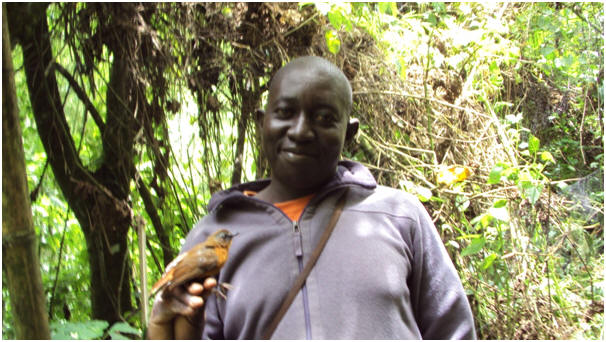|
Conservation efforts often are focused on regions or sites that support threatened, endemic or rare species. With increasing threats of global climate change, knowledge of distribution and abundance patterns of species of conservation concerns can be an important argument for protection of different areas. This study assessed the patterns of species richness, relative abundance and distribution of birds along an altitudinal gradient (1,384-2,604m) in Bwindi Impenetrable National Park (BINP), Southwestern Uganda, and covering 331km2. It also compared densities of the commonest bird species in three broad altitudinal zones and assessed the general habitat features associated with altitudinal distribution of species of conservation concern especially Albertine Rift Endemics (ARE). Surveys were conducted along altitudinal gradients on six selected hills covering valley bottoms, midslopes, and ridgetops using mist-netting and Timed Point Counts from October 2009 to April 2010. A linear regression technique was used to assess the relationship between bird species richness, number of individuals and altitude. Densities were estimated by the DISTANCE computer program, One Way Analysis of Variance (ANOVA) and Tukey’s Post hoc tests were used to test the differences in species abundance among altitudinal zones and slope positions. Canonical correspondence analysis (CCA) was used to explore the patterns of variation in endemic and globally threatened bird species distributions’ explained by the habitat variables recorded.

Malinga Geoffrey
Maxwell
(researcher)-holding
Archer’s Robin chat,
one of the Albertine
Rift endemic bird
species.
Mist-net data showed that forest specialist bird species richness and number of individuals caught decreased with increasing altitude while those of ARE species increased with increasing altitude. Point counts however revealed that both the number of species and number of individuals for ARE and for all bird species increased with increasing altitude. Relative abundance of most species did not differ significantly among slope positions. Altitudinal ranges of 161 bird species in BINP were established. Ecologically related or congeneric species showed altitudinal overlap. The most abundant of the commonest species was Yellow-whiskered Greenbul which occurred at all altitudes. Altitudinal variation in density was significant in only seventeen cases while all the seven restricted range species for which estimates were obtained achieved highest densities at higher altitudes. Collectively, endemic and globally threatened species were associated with various habitat features. CCA revealed that the most important habitat variables significantly associated with the distribution of ARE species in BINP were: altitude, stem density, presence of stream or watercourse, ridgetop and vegetation canopy cover. The results are discussed in terms of conservation implications for bird habitats and species management in response to climate change.
While results of this study form useful baseline data for future monitoring of impacts of climate change, including altitudinal shifts in distribution and localized declines in abundance, conservation efforts for avifauna in BINP will require setting up a consistent multi-year monitoring programme and preserving structural diversity of forest habitats over the entire altitudinal range.
|


